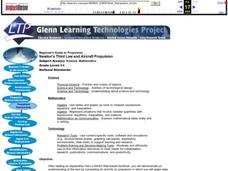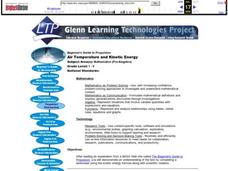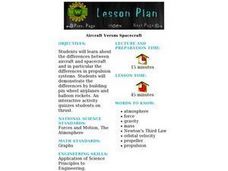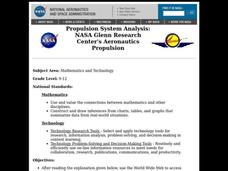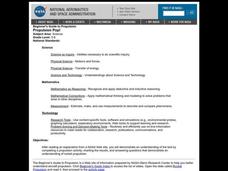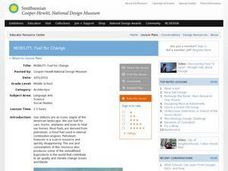Curated OER
Forces, Controls And Aircraft Systems
Students are introduced to the physics of flight through video and PowerPoint presentations. They construct and fly model gliders and compete for height, distance, time, etc.
Curated OER
Newton's Third Law and Aircraft Propulsion
Students research propulsion, graph data, and interpret the results.
Curated OER
Air Temperature and Kinetic Energy
Students use a NASA website do activities which help them better explain how air temperature and kinetic energy are related to aircraft propulsion.
Discovery Education
Jets in Flight
This Discovery Education activity provides the information needed to understand the basics of flight. Before taking off, young pilots learn the eight stages of the engineering design process. Small groups then design and build an...
Curated OER
Aircraft vs. Spacecraft
Students investigate differences between aircraft and spacecraft, and the differences in propulsion systems. They build pinwheel airplanes and balloon rockets. An interactive activity quizzes students on thrust.
Curated OER
Balloon Rockets
Students build pinwheel airplanes and balloon rockets to determine which ones fly faster and which fly farther.
Curated OER
Aeronautics Propulsion
Students use the World Wide Web to access additional information needed to complete the activities on the forces on an airplane, the function of the stabilizer, and the calculation of Mach speed, temperature, pressure, and thrust.
Curated OER
Rotocopters
Students construct their own rotocopters to study flight. For this flight lesson students work in groups and complete timed trials of their rotocopters.
Curated OER
Propulsion Pop!
Learners demonstrate an understanding of the text by completing a propulsion activity, charting the results, and answering questions that demonstrate an understanding of rocket propulsion.
Curated OER
Forces in a Climb
Students use a NASA website to use a given formula to find acceleration and distance after a specific time and how it relates to engine propulsion.
Curated OER
Model Rockets
Students build a model rocket. In this model rocket lesson, students explore a rocket launch cycle. Students investigate the laws of physics for each part of the launch. Students build model rockets and launch at school.
Curated OER
Geometry and Shapes in the X-36
Students describe, draw, and classify shapes. They use the internet to research the X-36 aircraft. Students identify the geometric shapes in the aircraft. They calculate the number of sides in an x-36.
Curated OER
Forces in a Climb - Vectors
High schoolers read Forces in a Climb from the Beginner's Guide to Propulsion, and explain each of the formulas using vectors.
Curated OER
Thrust to Weight Ratio and Excess Thrust
Students, after reading an explanation from a NASA Web site, demonstrate an understanding of the text by applying it to questions involving the Thrust to Weight Ratio and Excess Thrust of an aircraft.
Curated OER
Trajectory and Range of a Projectile
Students investigate the factors affecting projectile trajectory. In this physics lesson, students calculate the range, time and speed of projectiles using mathematical equations.
Cornell University
Catapults
Ready, aim, fire! Launch to a new level of understanding as scholars build and test their own catapults. Learners explore lever design and how adjusting the fulcrum changes the outcome.
Curated OER
Sand or Rock? Finding Out From 1,000 km
Students observe how measurements are made with different instruments. In this remote sensing lesson students investigate the physical state of surfaces including the surfaces of the solar system.
Curated OER
Magnetic Levitation
Students conduct a series of experiments on magnetic levitation. In this physics lesson, students discover how Maglev trains operate. They explain how magnetism make even simple objects levitate.
Curated OER
Maglev Trains
Students explore how Maglev trains work. In this technology lesson plan, students discuss the pros and cons of Maglev compared to conventional trains. They build a simple Maglev train model.
Curated OER
What Would You Fly?
Students, after reading an explanation from a NASA Web site, demonstrate an understanding of the text by writing an essay that applies the information found in the slides to a real-life question.
Curated OER
Mobility: Fuel for Change
Students determine how to lower the reliance on petroleum-based fuel. In this environmental stewardship lesson, students create concept cars for the future that using renewable energy.
Curated OER
Turbojet Thrust
Students, after reading the Web page Turbojet Thrust and completing the activity, explain how jet engines use air to produce thrust. The educational software ""FoilSim" is used in this lesson plan to help students calculate thrust.
Curated OER
Maximum Flight Time
Students, after reading an explanation from a NASA Web site, demonstrate an understanding of the text by applying it to questions involving Maximum Flight Time and Range under varying conditions.
Curated OER
Fuel and Air Relationships
Students use EngineSim and information found on the World Wide Web to complete the activity on the relationship between the atmosphere and jet fuel. They discover how much air is required to pass through a jet engine.



